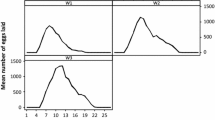Abstract
The life cycle of Ixodes persulcatus lasts 3 years in the conditions of the Leningrad province (North-West Russia), the development of each phase taking a year. The normal age of the taiga tick is 3 years. The calendar age of larvae and nymphs reaches 11–12 months under favorable abiotic and biotic factors, while the calendar age of adults does not exceed 11 months. At the preimaginal phases of development the ticks that breed in August can feed before or after winter. However, their metamorphosis begins and reaches completion within the same timeframes (from late June to early August) and lasts for about 30–50 (60) days. The survival rate of hungry and engorged larvae and nymphs after wintering is quite high (88.6–100 %). We explain the low activity of larvae and nymphs in late summer and autumn by incomplete development. Morphogenetic diapause of engorged larvae and nymphs interrupts digestion but not metamorphosis which starts only in late June and July after the complete absorption of blood from the gut cavity.






Similar content being viewed by others
References
Babenko LV, Naumov RL, Leonovich CA, Shashina NI, Byelozyorov VN, Labzin VV, Arumova EA, Filippova NA (1985) In: Filippova NA (ed) Taiga tick. Ixodes persulcatus Schulze (Acarina, Ixodidae): morphology, systematics, ecology, medical importance: ecology. Nauka, Leningrad, pp 213–316 (in Russian)
Balashov YS (1967) Bloodsucking ticks (Ixodoidea)—vectors of diseases of man and animals. Nauka, Leningrad (in Russian)
Balashov YS (1989) Ecology of the nonparasitic stages of the life cycle of ticks. Parasitol Sb 36:56–82 (in Russian)
Balashov YS (1998) Ixodid ticks—parasites and vectors of infections. Nauka, Saint Petersburg (in Russian)
Balashov YS (2010) The significance of ixodid tick (Parasitiformes, Ixodidae) population structure for maintenance of natural foci of infection. Zool J 89:18–25 (in Russian)
Balashov YS (2012) Demography and population models of ticks of the genus Ixodes with long-term life cycles. Parasitologiya 46:81–90 (in Russian)
Balashov YS, Grigoryeva LA (2010) Estimation of the biological age in taiga tick females (Ixodes persulcatus: Ixodidae) by the fat reserves in organism. Parasitologiya 44:289–296 (in Russian)
Byelozyorov VN (1981) Ecological rhythms of ixodid ticks and their regulation. Parasitol Sb 30:22–46 (in Russian)
Byelozyorov VN (1998) Role of two-step photoperiodic reaction in the control of development and diapause in the nymphs of Ixodes persulcatus. Zool Zh 77:885–890 [In Russian]
Dobson AD, Finnie TJR, Randolph SE (2011) A modified matrix model to describe the seasonal population ecology of the European tick Ixodes ricinus. J Appl Ecol 48:1017–1028
Estrada-Peña A, Estrada-Sanchez D (2014) Deconstructing Ixodes ricinus: a partial matrix model allowing mapping of tick development, mortality and activity rates. Med Vet Entomol 28:35–49
Filippova NA (1977) Ixodid ticks subfamily Ixodinae (Fauna USSR). Arachnida 4(4):319–330 (in Russian)
Grigoryeva LA (2007) Morphofunctional changes in the midgut of the Ixodes ricinus nymphs (Acarina: Ixodidae) during developmental diapause. Parasitologiya 41:23–27 (in Russian)
Grigoryeva LA (2011) Morpho-functional changes in organism of feeding ticks, Ixodinae. LAP LAMBERT Academic Publishing, Saarbrücken (in Russian)
Grigoryeva LA (2012) Estimation of the biological age in taiga tick males (Ixodes persulcatus: Ixodidae) by the fat reserves in midgut. Parasitologiya 46:226–230 (in Russian)
Isachenko GA (2002) General description of the natural environment. In: Volkova EA, Isachenko GA, Khramtsov VN (eds) Komarovskiy coast—complex natural reserve. Saint Petersburg, pp. 6–21 (in Russian)
Korenberg EI (1974) Some problems of population ecology of ixodid ticks. Zool J 53:165–178 [In Russian]
Randolph SE (2004) Tick ecology: processes and patterns behind the epidemiological risk posed by ixodid tick vectors. Parasitology 129:37–65
Serdyukova GV (1948) Detection method of duration of life cycle in ticks by family Ixodidae. Parasitol Sb 10:41–50 (in Russian)
Zolotov PE, Kuznetzova PI (1967) On the forecasting of the abundance of Ixodes persulcatus P. Sch. and the morbidity with tick-borne encephalitis in the Leningrad region. Parazitoloiya 1:246–249 (in Russian)
Acknowledgments
The research was partly supported financially by a Grant from the Russian Foundation for Basic Research (RFFI), Grant N 15-04-01203. We are grateful for idea of research and overall support our Chief Prof. Yuri S. Balashov. All applicable international guidelines for care and use of animals were followed.
Author information
Authors and Affiliations
Corresponding author
Rights and permissions
About this article
Cite this article
Grigoryeva, L.A., Stanyukovich, M.K. Life cycle of the taiga tick Ixodes persulcatus (Acari: Ixodidae) in the North-West of Russia. Exp Appl Acarol 69, 347–357 (2016). https://doi.org/10.1007/s10493-016-0038-1
Received:
Accepted:
Published:
Issue Date:
DOI: https://doi.org/10.1007/s10493-016-0038-1



